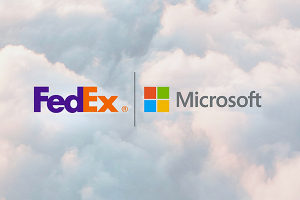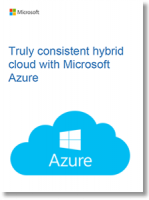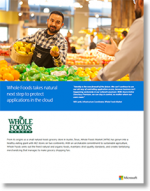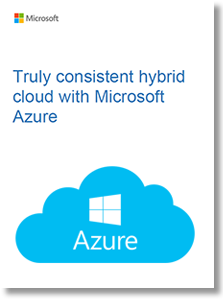Truly Consistent Hybrid Cloud with Microsoft Azure
If you’re looking for a holistic computing environment that lets on-premises resources and the cloud smoothly work together, provides a unified approach to management, and allows a single identity everywhere, you’re looking for the Microsoft hybrid cloud.
Why use a hybrid cloud?
Cloud computing gets a lot of attention, and for good reason: it’s where much of IT is going.
But on-premises datacenters also have an important role to play, both today and in the future.
For many organizations, integrating these two to create a hybrid cloud is essential.
Microsoft understands this reality.
To help you achieve it, we offer a broad range of cloud and on-premises technologies that work together in a coherent way.
And unlike our competitors, we provide the flexibility to let you choose the path that’s right for you. We’re committed to providing a consistent hybrid cloud that supports the approach you pick.
What exactly is a hybrid cloud?
While getting everyone to agree on a definition isn’t easy, there are some obvious requirements.
For example, you need a way to connect your on-premises datacenters with the cloud, a problem Microsoft solves with Azure Virtual Networks, Azure ExpressRoute, and more.
But basic connectivity isn’t enough; a hybrid cloud should go beyond this, providing a complete set of consistent services.
Microsoft believes that a true hybrid cloud must provide four components, each of which brings significant benefits. They are the following:
- Common identity for on-premises and cloud applications. This improves user productivity by giving your users single sign-on to all of their applications.
- Integrated management and security across your hybrid cloud. This enables a cohesive way to monitor, manage, and help secure your environment, giving you increased visibility and control.
- A consistent data platform for your datacenter and the cloud. This gives you data portability, combined with seamless access to on-premises and cloud data services for deep insight into your data.
- Unified development and DevOps across the cloud and your on-premises datacenters. This lets you move applications between the two environments as needed, and it also improves developer productivity, since both places now have the same development environment.
Taken together, these four requirements provide consistent experiences for developers, data professionals, IT managers, and users.
Figure 1 summarizes this, showing example Microsoft technologies for each one.

What’s Related




Favorites





